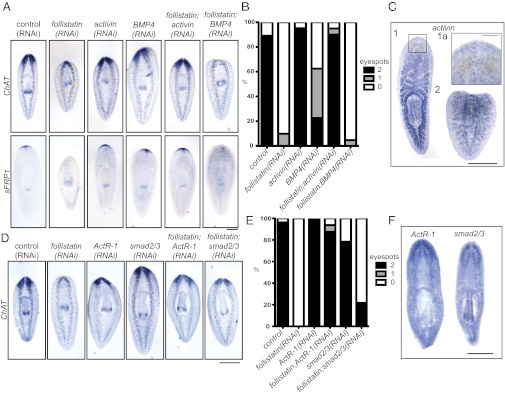Fig. 3.

Planarian follistatin inhibits activin. (A) activin(RNAi) combined with follistatin(RNAi) rescues nervous system regeneration and anterior polarity, whereas a combination of BMP4(RNAi) and follistatin(RNAi) does not lead to rescue of these phenotypes. In situ hybridization with ChAT and sFRP-1 probes illustrates nervous system and anterior polarity, respectively, in 5-d regenerates. (B) Concomitant activin(RNAi) and follistatin(RNAi) rescues the follistatin(RNAi) phenotype, as evidenced by eyespot regeneration (n ≥ 40 each). (C) Whole-mount in situ hybridization with an activin probe indicates expression in the gut and pharynx (1) and in ventral spots along the animal and in the head (boxed area, 1a). The punctate expression pattern is dominant in 2-d regenerating tail pieces (2). (D) Simultaneous knockdown of follistatin with ActR-1 or smad2/3 by RNAi rescues the follistatin(RNAi) phenotype. dsRNA-fed animals 5 d after amputation were subjected to in situ hybridization with the ChAT probe to illustrate regeneration of the nervous system. (E) Eyespot quantitation after RNAi and 5 d of head regeneration. Concomitant treatment with ActR-1(RNAi) rescues the follistatin(RNAi) phenotype, and treatment with smad2/3(RNAi) partially rescues the follistatin(RNAi) phenotype (n ≥ 30 each). (F) ActR-1 and smad2/3, detected by whole-mount in situ hybridization, are broadly expressed but neurally enriched. [Scale bars, 500 µm (A, C, D, and F) and 100 µm (C, Inset).] Anterior is up.
